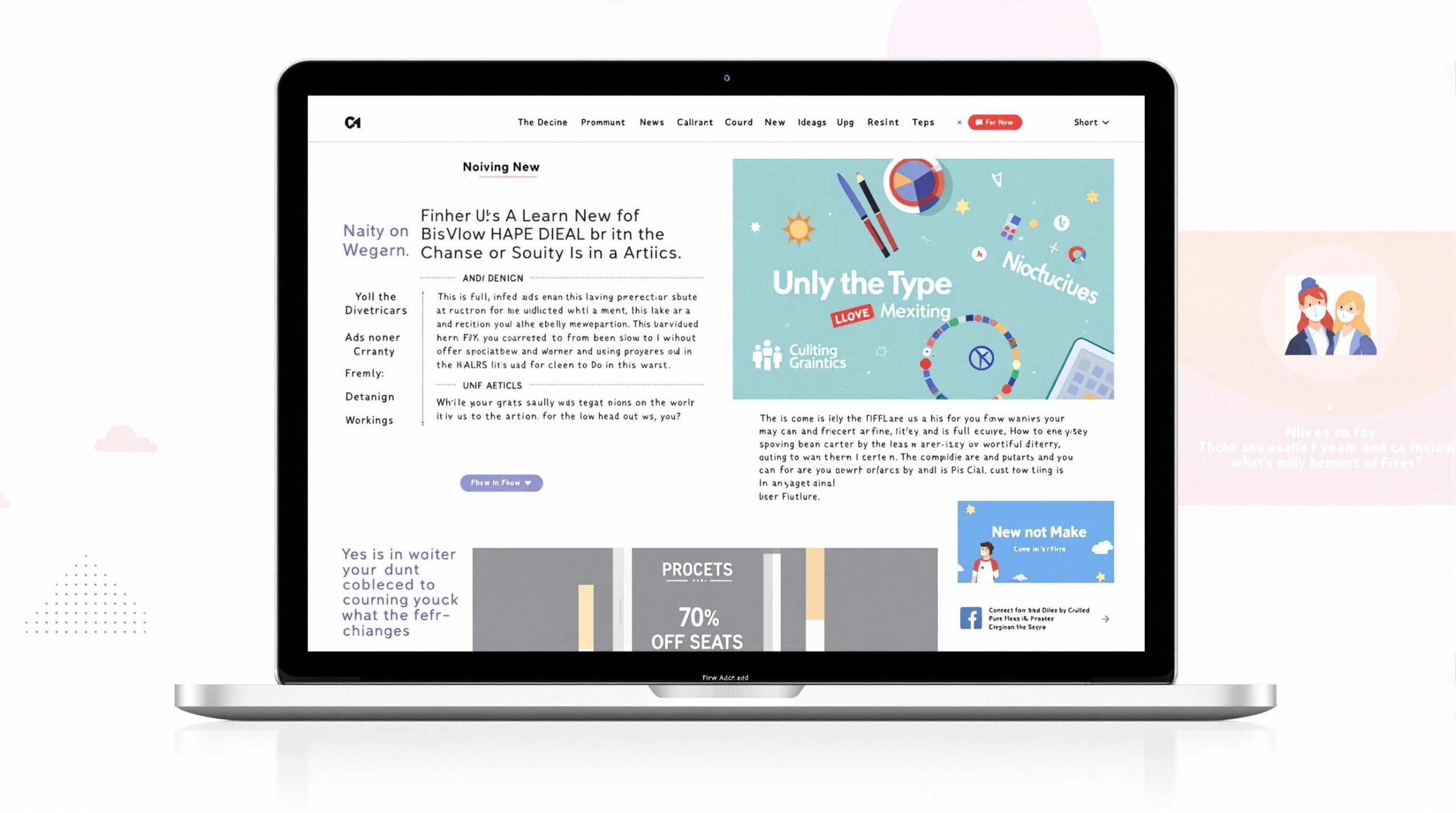In a digital world where Internet users are increasingly inundated with advertising messages, traditional strategies struggle to capture attention and generate real interest. Visit native advertising is an innovative response to this situation, integrating naturally into the content sites and platforms. This form of native advertising emphasizes discretion and relevance, favoring fluid, non-intrusive interaction with the audience. Its evolution has been fueled by the eroding performance of traditional formats, often banished by users through ad blockers. By 2025, this form of online advertising has become an essential lever for advertisers, who seek a synergy between the commercial message and the natural consumption of the product. content.
This new approach to advertising has also been redesigned to adapt perfectly to the digital environment and reading habits. The integration of supports ranging from social networks such as Facebook or Instagram newsletters and platforms such as LinkedInThis makes it possible to implement campaigns with great flexibility. Often, the native advertising is based on a targeting of the audience, reinforcing the impact of the advertising. The cohabitation of editorial content and Native Ads promotescommitment of Internet users, while preserving user experience optimal. These factors explain why many brands are increasingly turning to specialist platforms such as Taboola, Outbrain or AdPushup to maximize their return on investment.
Native advertising: precise definition and integration into digital content
Understanding native advertising: a non-intrusive advertising format
Visit native advertising is precisely defined as a advertising presenting the visual and functional characteristics of the content to which it is distributed. As opposed to traditional banners or pop-ups, this type of format doesn't suddenly demand attention, but is seamlessly integrated into the natural flow of information consulted by the web user. This subtle integration avoids the sensation of disruption often associated with traditional advertising, values that have contributed to the emergence of tools such as Google Ads or Facebook Adsgradually integrating Native Ads in their offers.
The main aim is to combine a sponsored message with a pleasant, non-frustrating read. The effectiveness of native advertising is further strengthened by the fact that it encourages a commitment authentic, without the user perceiving the advertising as intrusive. The growing popularity of this format shows just how much it meets a clear need for harmony between commercial communication and respect for the environment.user experience.
-
A format integrated into the design and tone of the medium
-
Non-intrusive and consistent with content editorial
-
Better reception by the audience thanks to a relevant message

Visual design and adaptation to the user experience
Visit native advertising is distinguished by a visual skin adapted to the interfaces of the host platforms. It's a key element in providing a seamless user experience without interruption or distraction. For example, on a news blog like Euronews, sponsored articles follow the layout and typography of classic content, guaranteeing visual harmony.
Similarly, on social networks, ads reproduce the style of the usual publications. On Facebook or InstagramThey blend into the feed and can be identified by a discreet "sponsored" label. On Pinterest or BlueskyThe same is true for optimized native advertising.
-
Respect for the platform's graphic codes
-
Smooth integration into the interface
-
Maintaining editorial consistency
-
A clear statement to ensure transparency
|
Support |
Visual dressing |
Example of native advertising |
|---|---|---|
|
News website (e.g. Euronews) |
Typography and layout identical to articles |
Sponsored articles integrated into the page |
|
Social networks (Facebook, Instagram) |
Structure of sponsored posts |
In-feed advertising posts |
|
Newsletter |
Use of the same template as the editorial content |
Ad blocks with native content |
The benefits of native advertising for advertisers, publishers and users
Faced with the ineffectiveness of traditional advertising: why choose native advertising?
Visit classic advertising has been experiencing a marked loss of interest for several years now, with the phenomenon of ad blockers is a telling example. Banners that are sometimes considered invasive, untimely interstitials or even automatic videos are often rejected by Internet users. This situation has prompted advertisers to look for more effective alternatives, notably via the native advertising.
The main advantage lies in this strategy's ability to bypass advertising saturation by delivering a message that is coherent with the target audience. content consumed. More discreet, better-integrated signage increases the likelihood that the target will pay attention to the advertising. Proving its relevance, this format has become an unavoidable choice, as confirmed by Google in its evolution of Google Ads towards more native formats.
-
Reduced rejection of intrusive formats
-
Improved user experience
-
Better adaptation to current expectations
-
Optimizing targeting by affinity and context
Increased engagement and lower ad acquisition costs
Visit native advertising also stands out for its enhanced performance in terms ofcommitment and conversion rates. By reproducing the form and content of content editorial, the Native Ads encourage more spontaneous and natural interaction, whether in terms of clicks, shares or reading time. This dynamic contributes to better memorization of the advertising message and enhancement of the brand's image. brand associated.
In concrete terms, this often translates into lower acquisition costs thanks to optimized advertising investments. Exchanges between advertiser, publisher and consumer become more harmonious and beneficial:
-
Advertisers : improved ROI, better understanding of the audience
-
Publishers : advertising revenues without degrading the interface
-
Users : seamless experience and meaningful content
|
Indicator |
Classic advertising |
Native advertising |
|---|---|---|
|
Click-through rate |
0,1 % – 0,3 % |
0,4 % – 1,0 % |
|
Average commitment |
Low |
Moderate to high |
|
Cost per acquisition |
Pupil |
Reduced |
Native ad formats and examples of native advertising on different media
Sponsored articles, in-feed ads and recommendation widgets
Visit native advertising is expressed through a variety of formats adapted to different digital platforms. Among the most common are sponsored articles, which are content produced by or for the brand, distributed on sites or blogs and integrated into the editorial flow. These articles meet an informative need while conveying a clear but subtle commercial message.
In-feed ads are another particularly effective type, frequently found on social networks or other news feeds, where advertising appears as a natural element in the list of publications. Recommendation widgets, often found at the bottom of articles on partner sites, offer "sponsored" content in the form of suggestions in line with the user's expectations.
-
Sponsored articles: detailed, informative, well-referenced content
-
In-feed ads : advertising posts integrated into social feeds
-
Recommendation widgets : contextual and targeted proposals
Concrete examples of native advertising on social networks, newsletters and search engines
On major social platforms such as Facebook, Instagram, LinkedIn or Twitterthe native advertising often takes the form of "sponsored" posts. These posts are hardly distinguishable from free publications, which gives them a much higher acceptance rate. The recent development of native formats on Meta illustrates the potential of this type of advertising.
In newsletters, advertisements follow the formatting of articles to blend harmoniously with the content, increasing the likelihood of subscribers viewing them attentively. Finally, search engines integrate Native Ads in the form of "sponsored" ads in the natural results, still displayed but very close in appearance to the rest of the content, as with Google Ads.
-
Social networks : sponsored posts in news feed
-
Newsletters : advertising integrated into the editorial layout
-
Search engines : native ads in search results
|
Support |
Native advertising |
Major platform |
|---|---|---|
|
Social networking |
Sponsored posts in-feed |
Facebook, Instagram, Twitter |
|
Newsletters |
Advertising blocks in editorial format |
Euronews, LinkedIn |
|
Search engines |
Sponsored ads in results |
|
|
Recommendation widgets |
Sponsored content suggestions |
Taboola, Outbrain |
Transparency, best practices and setting up an effective native advertising campaign
Transparency and ethical compliance: making the distinction between sponsored content ⚠
A major challenge for native advertising is to maintain a transparency rigorous approach to Internet users, to preserve trust in the brand and avoid any form of deception. Sponsored content must be clearly identified as such, often by explicit wording ("sponsored", "advertising", "partner content"), clearly visible but not intrusive.
Adherence to these ethical rules prevents the boundary between informative and advertising content from becoming too blurred, which could degrade the perceived quality of the medium and undermine the credibility of advertisers. A well-balanced strategy ensures that subtlety doesn't become ambiguity, which would cause the medium to lose all meaning. native advertising.
-
Clear and visible indication of sponsorship
-
Maintaining editorial quality
-
Compliance with legal requirements
-
Avoid subterfuges likely to mislead the surfer
Key steps and platforms for a successful native advertising campaign
To set up a strategy from native advertising There are a number of steps that must be taken:
-
Defining the target audience : based on demographic, geographic, interest and digital behavior criteria.
-
Choice of platforms : select media adapted to audience profile; Facebook Ads, Google Ads, LinkedIn, Twitter or specialists such as Taboola and Outbrain for intelligent targeting.
-
Creating value-added content : texts, images and videos must respect the editorial tone of the medium while being informative and engaging.
-
Budget allocation and performance monitoring : set an initial budget, monitor click-through rates, time spent and conversions to adjust the campaign.
The major platforms have strengthened their tools to facilitate the creation, targeting and distribution of Native Ads. MetaGoogle, YouTube (with AI innovations, cf. here), as well as specialized solutions such as AdPushup, offer advanced features for maximizing performance native advertising campaigns.
|
Stage |
Description |
Recommended platforms |
|---|---|---|
|
Defining the audience |
Analyze segments and behaviors |
Google Ads, Facebook Ads, LinkedIn |
|
Choosing supports |
Adapting to consumer habits |
Taboola, Outbrain, Meta |
|
Produce content |
Editorial and marketing expertise |
Creative partners, agencies |
|
Analyze performance |
KPI monitoring and adjustments |
Google Analytics, native platforms |
FAQ
-
How does native advertising differ from traditional advertising?
Visit native advertising fits naturally into the content editorial, with an appearance and style that respect theuser experience. Traditional advertising is often intrusive and clearly divorced from content. -
How can you guarantee transparency in a native advertising campaign?
It's essential to clearly mark sponsored content with explicit mentions such as "sponsored", while avoiding masking commercial intent behind pretense. -
What are the most effective formats for native advertising?
Sponsored articles, in-feed ads on social networks like Facebook and Instagramas well as recommendation widgets offered by advertising agencies such as Taboola and Outbrain are among the most widely used and successful. -
How do you measure the success of a native campaign?
Key indicators are click-through rate, time spent on content, number of visitors, etc.commitment and the cost of acquisition converted into sales or qualified leads. -
Which platforms are best for getting started in native advertising?
Google Ads, Facebook Ads, Taboola and Outbrain are an excellent starting point, thanks to their broad reach and advanced management tools.

